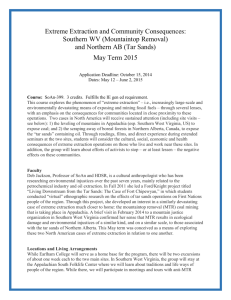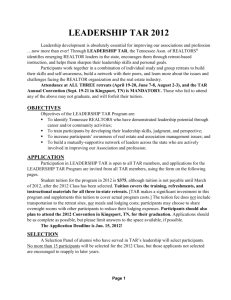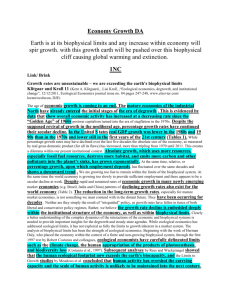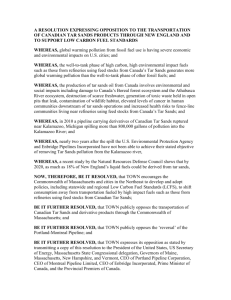File - Steven Zuardo
advertisement
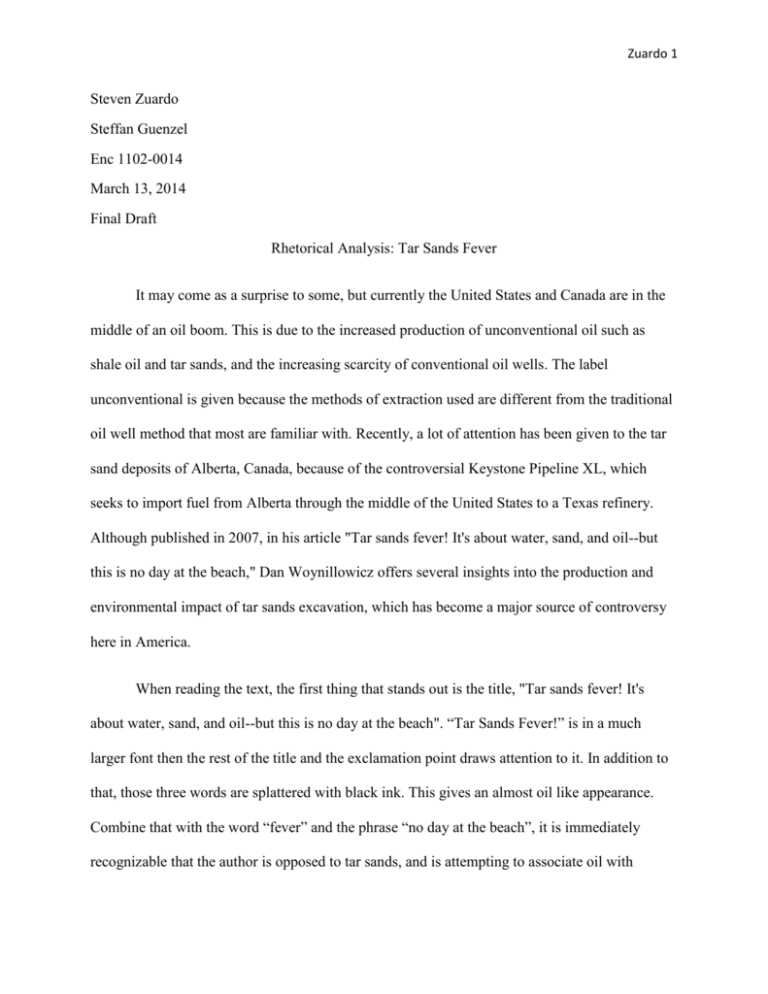
Zuardo 1 Steven Zuardo Steffan Guenzel Enc 1102-0014 March 13, 2014 Final Draft Rhetorical Analysis: Tar Sands Fever It may come as a surprise to some, but currently the United States and Canada are in the middle of an oil boom. This is due to the increased production of unconventional oil such as shale oil and tar sands, and the increasing scarcity of conventional oil wells. The label unconventional is given because the methods of extraction used are different from the traditional oil well method that most are familiar with. Recently, a lot of attention has been given to the tar sand deposits of Alberta, Canada, because of the controversial Keystone Pipeline XL, which seeks to import fuel from Alberta through the middle of the United States to a Texas refinery. Although published in 2007, in his article "Tar sands fever! It's about water, sand, and oil--but this is no day at the beach," Dan Woynillowicz offers several insights into the production and environmental impact of tar sands excavation, which has become a major source of controversy here in America. When reading the text, the first thing that stands out is the title, "Tar sands fever! It's about water, sand, and oil--but this is no day at the beach". “Tar Sands Fever!” is in a much larger font then the rest of the title and the exclamation point draws attention to it. In addition to that, those three words are splattered with black ink. This gives an almost oil like appearance. Combine that with the word “fever” and the phrase “no day at the beach”, it is immediately recognizable that the author is opposed to tar sands, and is attempting to associate oil with Zuardo 2 something unpleasant and dangerous such as a fever. Fever also describes the boom in production rates for tar sands in recent years. This is an emotional appeal to the reader, and seeks to evoke feelings of trepidation concerning tar sands. The same imagery is used throughout the paper at each sub-heading. Besides the title very few emotional appeals are made throughout the text. Some of the wording seeks to evoke emotion from the reader such as, “scrapping the bottom of the oil barrel” (Woynillowicz 1). The biggest emotional appeal however, are the pictures shown of the mining operations at the end of the article. These pictures show a desolate industrial wasteland populated with large cranes and thick black sludge in containers, showcasing the supposed destruction of environment.The author of this article Dan Woynillowicz, is well acquainted with the subject of Canadian tar fields. According to biographical information posted by the Pembina Institute he is a Canadian citizen who holds a master’s degree in environment and management (Dan Woynillowicz 1). He is also a former employee of the Pembina institute, a Canadian non-profit think tank, in which he led the institutes tar sands program (Dan Woynillowicz 1). Woynillowicz currently serves as the director of policy at Clean Energy Canada, at Tides Canada, another non-profit organization focused on promoting clean energy use.Throughout the article Woynillowicz draws on knowledge from these occupations to criticize tar sands production. He very clearly takes a concerned environmentalist approach when describing its effects, most obviously seen in his diction. Woynillowicz starts the article noting the energy relationship between Canada and America. The United States receives ninety-nine percent of Canadian oil exports (Woynillowicz 1). The discussion about unconventional oil soon develops. In 2003, when the U.S. Department of Energy acknowledged tar sand reserves in Canada, it placed Canadian oil reserves at the second highest in the world (Woynillowicz 1). Demand from the United States led to a rapid Zuardo 3 increase in tar sands extraction, which comes in two forms. There is strip mining, in which a large amount of land is cleared away to reach the bitumen underneath. Bitumen is the fossil fuel found in tar sands, after it is extracted it is separated from sand and mixed with a chemical called naphtha to form oil (Woynillowicz 1). Then there is in-situ mining. This technology requires high pressure steam to be injected into the ground so that the bitumen can be pumped to the surface (Woynillowicz 1). Both of these mining practices have various environmental consequences, which is where the authors claim presents itself. Woynillowicz contends that as conventional oil sources diminish, our reliance on unconventional oil will rise dramatically, and in its current state, tar sands production poses an unprecedented threat to our environment. Woynillowiczs’ detailing of the environmental impacts was quite extensive, not much of a surprise knowing his background. He divides the subheading “Impacts” into three smaller ones, “Forests, Waters, and Air.” He also uses a map to display the tar fields, and several pictures of oil mining operations. The tar sand fields of Canada are found mostly in the province of Alberta, under a large swath of boreal forests that account for twenty-five percent of the world’s remaining intact forest (Woynillowicz 1-3). Both types of mining require some deforestation. However, strip mining operations require the entire affected area to be cleared in order for excavation to take place. These areas are then supposed to be reclaimed after excavation is done, but Woynillowicz believes that this is not the case. The author continues to discuss bitumen extraction in the following paragraphs. After extracting the bitumen, a large amount of water is then needed to separate the bitumen from sand. In-situ mining in particular requires a significantly higher amount of water, and a continuous stream of water to pump into the ground to extract the bitumen. The water used in the extraction is taken from groundwater aquifers, overdrawing can cause the water table in the Zuardo 4 region to shrink, thereby shrinking the wetlands, (Woynillowicz 3). In addition, because of the volume of water usage, a high amount of waste is produced. This waste, in the form of toxic sludge, is dumped into tailing ponds. Woynillowicz rstatesthat the likelihood for these tailing ponds to leak into ground water, or nearby wetlands is high, and that the chemicals found within could contaminate water supplies and threaten wildlife. Woynillowicz also states that the Athabasca River does not have sufficient water flow for the continued use of tar sands operations; even while noting that it is historically believed that the river does (Woynillowicz 4). Woynillowicz then briefly touches on air pollution. At the time of the texts publication, Alberta had been the industrial air pollution capital of Canada since 2003 (Woynillowicz 5). Woynillowicz does not specifically say this is the result of tar sand excavation. However, it is strongly implied, when he states that tar sand extraction produces triple the amount of carbon emissions than conventional oil extraction, the heat required to move the bitumen means large amounts of natural gas are burned (Woynillowicz 4). While Woynillowicz extensively details the effect of tar sand production, he gives zero mention to any counter arguments, or any response from the companies themselves. Rather than debunking the statements of the oil companies involved in the production or the failure of the laws that are regulating them, Woynillowicz attacks the process itself. This causes the article to give the impression of having a one-sided view, and slightly lessens the credibility of the article itself. Also the article will not be received positively by those who favor oil production, because it will be viewed as an attack on the trade. Rather than attempting to build a consensus, those people will react defensively and reject Woynillowiczs’ claim. Oneissue with the article is its out of date statistics. Although the sources used are credible, most of them coming from agencies like the U.S. State Department or the Canadian Zuardo 5 equivalent, since the text was published in 2007 some of the information is outdated. As the author relies heavily on statistics which are now seven years old it presents a problem for things such as oil production and carbon emissions which are subject to change. However some of the statistics used are unaffected by the seven-year gap, such as the amount of oil that the tar sands hold, 1.7 trillion (Woynillowicz 1). While at the time these sources were up to date and perfectly legitimate, it would be impossible now for someone to use them to accurately detail Alberta’s oil field because of the effect time has had on the sources. Other ways that the author appeals to the audience is through visuals. Most of the illustrations in the article are diagrams that describe the process of extraction using arrows and steps, or maps that show the affected areas. Also, when referring to tar sand production countless statistics are used to support the point like, “Since 1990, Canada’s Total emissions have risen 25.3 percent…..”(Woynillowicz 2) .Woynillowicz lists the amount of water used in barrels and cubic meters, compares its volume to that of conventional oil use, and traces the Athabasca River back to all of the different water sources it’s connected to in order to determine which sources would be effected (Woynillowicz 3). These are logical, factual approaches to describing the subject at hand, and this approach is taken again and again throughout the article. This approach gives the text validity and credibility. The use of diagrams to depict the mining process shows that Woynillowicz is familiar with the subject, while the use of statistics to support his claim gives the impression that his claim is factually based. Throughout the text Woynillowicz stays true to his claim, avoiding any contradictory points that would undermine it. It is obvious however, that Mr. Woynillowicz is biased against Zuardo 6 tar sand production, and this manifests in his perspective on the issue. The bias is easily discerned once his credentials are known, he writes from an environmentally concerned perspective. The author uses non-rational appeals, and reaches his audience mostly through logos and pathos, but he does present himself as knowledgeable on the subject. Overall the article is successful in getting its point across to its audience, though it suffers from some outdated figures, and a lack of a counterargument. Works Cited Zuardo 7 "Dan Woynillowicz." Pembina Institute. N.p., n.d. Web. 13 Mar. 2014. Woynillowicz, Dan. "Tar sands fever! It's about water, sand, and oil--but this is no day at the beach." World Watch 2007: 8. Academic OneFile. Web. 14 Mar. 2014.
